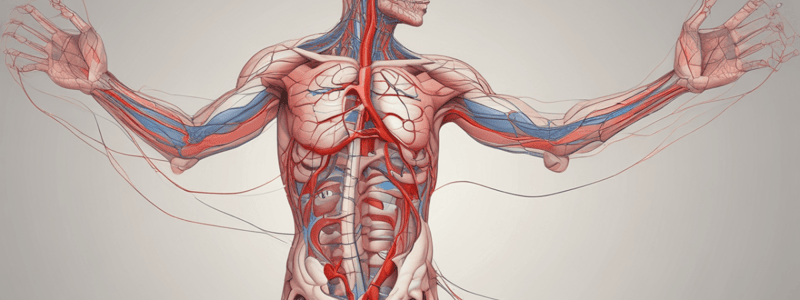Podcast
Questions and Answers
What is the purpose of the atrioventricular valves?
What is the purpose of the atrioventricular valves?
- To direct blood flow into the systemic circulation
- To prevent backflow into the aorta
- To regulate blood flow into the lungs
- To prevent backflow into the atria (correct)
Which valve lies between the left ventricle and the aorta?
Which valve lies between the left ventricle and the aorta?
- Tricuspid valve
- Bicuspid valve
- Aortic semilunar valve (correct)
- Pulmonary semilunar valve
What is the function of the collateral routes in the coronary circulation?
What is the function of the collateral routes in the coronary circulation?
- To pump blood from the heart to the aorta
- To supply blood to the lungs
- To ensure blood delivery to the heart even if major vessels are occluded (correct)
- To regulate blood flow to the systemic circulation
What is the purpose of the chordae tendineae?
What is the purpose of the chordae tendineae?
What is the direction of blood flow through the heart and lungs?
What is the direction of blood flow through the heart and lungs?
Flashcards are hidden until you start studying
Study Notes
Blood Flow Through the Heart
- Right atrium → tricuspid valve → right ventricle
- Right ventricle → pulmonary semilunar valve → pulmonary arteries → lungs
- Lungs → pulmonary veins → left atrium
- Left atrium → bicuspid valve → left ventricle
- Left ventricle → aortic semilunar valve → aorta
- Aorta → systemic circulation
Heart Valves
- Ensure unidirectional blood flow through the heart
- Atrioventricular (AV) valves:
- Lie between atria and ventricles
- Prevent backflow into atria when ventricles contract
- Anchored to papillary muscles by chordae tendineae
- Semilunar valves:
- Aortic semilunar valve: between left ventricle and aorta
- Pulmonary semilunar valve: between right ventricle and pulmonary trunk
- Prevent backflow of blood into ventricles
Coronary Circulation
- Functional blood supply to the heart muscle itself
- Collateral routes ensure blood delivery to heart even if major vessels are occluded
Studying That Suits You
Use AI to generate personalized quizzes and flashcards to suit your learning preferences.




